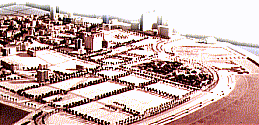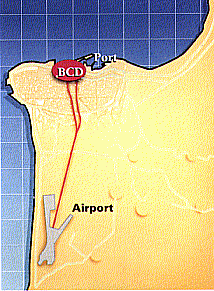|
Introduction
On May 5, 1994, The Lebanese company for the development and
reconstruction of Beirut Central District S.A.L., SOLIDERE, was formed, launching the
largest urban redevelopment project of the 1990s. Meeting at the sporting club in Ras
Beirut, The general assembly overwhelmingly elected a board of directors which will serve
three years. Outlined herein are the main objectives and structure of SOLIDERE. The
reconstruction and development of the war-torn Beirut Central District will involve a
surface area of approximately 1.8 million square meters that includes the most celebrated
public squares and avenues in what traditionally have been prime areas of the city.
Affected by the project are such landmarks as Martyrs' Square, the Parliament Building and
the Place de l'Etoile, the Serail and the traditional Souks of Beirut.
 Plans
for the rejuvenation of the BCD (Beirut Central District) will touch on virtually every
aspect of reconstruction and development. In addition to the complete installation of
modern infrastructure, including roads, utilities, public spaces and marine works, the
project will reclaim about 608,000 square meters from the sea, transforming what was
formerly a dumping site into public gardens, recreational and cultural areas, and office
space. Plans
for the rejuvenation of the BCD (Beirut Central District) will touch on virtually every
aspect of reconstruction and development. In addition to the complete installation of
modern infrastructure, including roads, utilities, public spaces and marine works, the
project will reclaim about 608,000 square meters from the sea, transforming what was
formerly a dumping site into public gardens, recreational and cultural areas, and office
space.
The project includes the reconstruction and development of 4.69
million square meters of built up space parceled out to ensure that the area will enjoy a
wide variety of activities. In the plans are a financial and office complex commanding a
superb view of the Mediterranean and Lebanon's mountains, the establishment of commercial
centers, hotels, centers for the arts, public parks and recreational areas on the sea
front, garden and pedestrian areas, and tree-lined promenades extending Beirut's famous
coastal boulevard. Half of the built-up area is reserved for residential development, to
make sure that the city has a life outside of business hours.
Located at the historical and geographical core of the city,
the vibrant financial, commercial and administrative hub of the country, the Beirut
Central District came under fire from all sides throughout most of the 16 years of
fighting. At the end of the war, that area of the city was afflicted with overwhelming
destruction, total devastation of the infrastructure, the presence of squatters in several
areas, and extreme fragmentation and entanglement of property rights involving owners,
tenants and lease-holders.
In addition, the Normandy garbage dump, formed in the course of
the war in the absence of an alternative dumping site, posed health and environmental
problems. The reconstruction of the BCD, which will attend to all of these concerns, comes
at a time when Lebanon is poised for a major economic recovery and the project is
sufficiently flexible to respond and contribute to this development.
 Next:
Solidere Next:
Solidere
|







